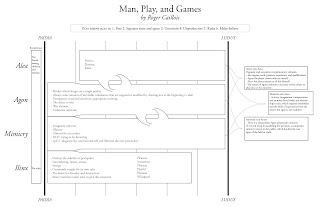The reading for week 3:
Johan Huizinga, Homo Ludens (excerpt)
Roger Caillois, Man, Play and Games (excerpt)
Assignment:
Due in class next Tuesday (1/26)
You should read Huizinga first and then Caillois. Your assignment is create a visual schema or diagram for Caillois's categories of play. What you make should demonstrate that you have thought through the relationship of each of these categories (agon, alea, mimicry, and ilinx) to the terms "paidia" and "ludus". This visual aid is due in class next week. It should be visually dynamic and well designed. It should be something that clarifies (rather than complicates) the relationships between these terms. I look forward to seeing what you come up with.
Rosalie:
 Jinney:
Jinney:
Ofri:
Laurel:
This is a "four-way chart" that shows how each game classification is ranked and identified in Caillois' dissertation. Agon games, for example, are in the "Ludus/Ludus" section due to their emphasis on rules and structure, while Alea games are in "Ludus/Paidia" due to their reliance on chance, even though they do have some rule structure to them.
Rosalie:
 Jinney:
Jinney:Ofri:
Mark:
To demonstrate my understanding of Callois’ categories of play, I would like to introduce a game to the class. Callois’ four forms are Agon, or competitive games; Alea, or chance games; Mimicry, or role playing games; and Ilinx, or movement based games. Callois’ two types of play are paidia and ludus, or playful unstructured activities and games with established rules. I will do this by playing a game with the class.
I will start my game by passing out a single playing card, face down, out of a deck of cards to each member of the class. They will be shuffled by me before hand. I will then write on the board:
diamonds (♦) = Agon
spades (♠) = Alea
hearts (♥) = Mimicry
and clubs (♣) = Ilinx
I will then pull a quarter from my pocket, and explain that heads = paidia and tails = ludus. The rules of the game at this point are simple. The cards are flipped when the result of the coin toss is called aloud. Once the cards have been flipped, the first person that writes three examples of play that matches both their cards form and the coins type of play. The catch is that before the coin is flipped, a classmate can choose to “preload” their card with two written games. They can choose to give themselves a head start in separate categories, or potentially, to have only one game left to think of. The odds of this are one in eight. This catch adds elements of both Agon and Alea to my game.
When a student announces themselves as winner, their card will be collected and their forms of play will be scrutinized by the class. If the class disagrees, the next fastest student will be scrutinized. When a winner is declared, all the cards will be collected, and that student will win the full deck of cards, with one classroom worth covered in excellent flash-card-like study material.
Richard:

Krista:

Kevin:

Richard:

Krista:

Kevin:

Laurel:
This is a "four-way chart" that shows how each game classification is ranked and identified in Caillois' dissertation. Agon games, for example, are in the "Ludus/Ludus" section due to their emphasis on rules and structure, while Alea games are in "Ludus/Paidia" due to their reliance on chance, even though they do have some rule structure to them.






No comments:
Post a Comment